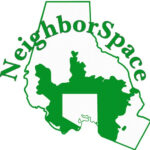Giving Tuesday, Giving Thanks for Quality of Life in Cherry Heights

This park is important for the Cherry Heights neighborhood because of what it will do for quality of life, or “livability,” there. The graphic below explains what we mean by “livability.” It includes things like improving Overlea’s park score of 56, which means that only 56% of Overlea’s residents can walk to a park within 10 minutes. The Trust for Public Land believes 100% of residents should be able to do so.
It also includes improving on Overlea’s walkscore of 49, meaning it’s considered a car-dependent place. Parks have so many benefits for health and well-being, the environment,
Another aspect of livability is the health of the environment. Like so many of the parcels NeighborSpace manages inside the URDL, Cherry Heights Woodland Garden has many trees that are plagued by a stranglehold of invasive vines and ivy. Various groups of volunteers, including middle school students from Bridges Baltimore, shown here, have spent the last nine months freeing the trees.
Trees control stormwater, clean air, reduce wind alleys, and provide a respite from summer heat. Understory trees, moreover, are essential for a healthy forest, ecosystem, even if it is just a small patch of trees. When trees are healthy, we can say that we have done something to improve the livability of the surrounding neighborhood.
Finally, among the social aspects of livability is history. The history of this site is challenging in that it includes the boundary of what was once a segregated neighborhood. The concept design for the park, which you can read more about here, proposes to highlight this history in which housing ownership was clearly delineated along racial lines. Inequality in housing, employment, and educational opportunities in the 20th century is responsible for disparities in economic opportunity, life expectancy, and annual income for African Americans today.
THANK YOU for helping us enhance livability in Overlea on #GivingTuesday. Click on the icon below for a short, 1-minute, THANK YOU video
